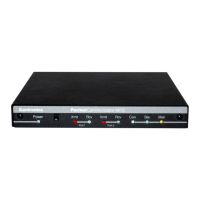KPC-9612 Version 5.2 July 19, 1994
32
• MXmit ON|OFF {ON/ON}
When ON, the KPC-9612 will display transmitted packets as monitored data on your terminal. Re-
peated packets will be displayed as they are sent over the radio. The frames to be displayed will
be controlled by the MONITOR, MCOM, MCON, and MRESP commands, and will obey the settings
of TRACE, MSTAMP, HEADERLN, 8BITCONV, CRSUP, LFSUP, and FILTER commands.
• MYAlias xxxxxx-
n
{none/none}
This command sets the alias to be used as a digipeater. The alias may be up to 6 characters (plus
optional SSID) which are different than those used for MYCALL, MYNODE, MYPBBS, MYREMOTE,
and MYGATE. To disable the alias function, give the command MYALIAS %.
See also: hid
MYcall xxxxxx-
n
This command tells the KPC-9612 what callsign to use for operation. When the KPC-9612 is first
turned on, or after a hard reset or a RESTORE D, it asks you for your callsign. The callsign you en-
ter is placed in this parameter. All packets originated by the KPC-9612 will contain this callsign in
the FROM address field. Any packets received by the KPC-9612 with this callsign in the TO address
field or digipeat fields will be responded to appropriately (connect, disconnect, ack, digipeat, etc).
See also: digipeat, id, myalias, mygate, mynode, mypbbs, myremote
• MYDrop
n
(
n
= 0 – 15) {0/1}
This command sets the Extended KISS address recognized by the KPC-9612 when used with the
G8BPQ multi-drop KISS Mode. The value before the slash identifies the 1200 baud port, and the
value after the slash identifies the 9600 baud port.
See also: intface, xkchksum, xkpolled
• MYGate xxxxxx-
n
{mycall-3}
Setting this parameter to a callsign or character string enables cross-port digipeating by using the
MYGATE. Enter up to six characters (plus optional SSID) which are different than those used for
MYCALL, MYALIAS, MYPBBS, MYREMOTE, and MYNODE. You may disable the gateway digipeating
with the command MYGATE %.
See also: hid

